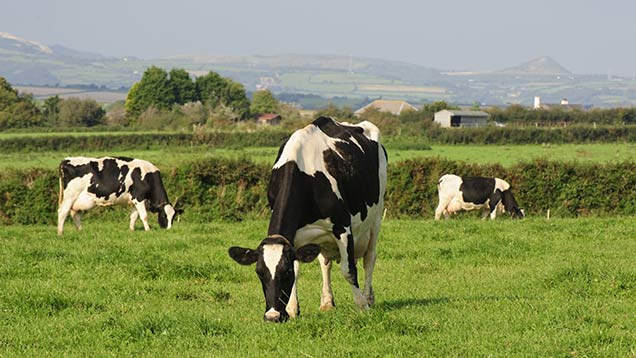7 summer management tips to protect dairy margins
 ©Image Broker/Rex Shutterstock
©Image Broker/Rex Shutterstock As grass quality declines it can be difficult to maintain yields from grazed cows. KW feeds offer some top tips to prevent production losses.
- Be realistic with potential milk yield from grazed grass, which peaks in mid-May at just maintenance plus 10-15 litres/cow, then drops towards zero by about mid-September as daylength shortens. Maximise milk from grass by maintaining sward quality, and choose buffer feeds that complement grazed grass rather than replacing it.
- Nutrient intakes are best maintained by focusing on both dry matter intakes (DMI) and ration nutrient density. Feeding 3kg DM of Traffordgold (6kg freshweight) might cost 5-10p/cow than the same quantity of brewers’ grains (12.5kg freshweight), but will supply an extra 5MJ ME that could mean the difference between losing condition or not if intakes are limited.
- The national average butterfat drop in mid-summer is 0.1-0.3%, potentially worth 0.4-0.6ppl. Optimise fibre digestion to support milk fat synthesis by keeping free oil levels below 5% and buffering rumen pH with digestible fibre feeds (such as sugar beet feed, soya hulls and the various distillers’ feeds) and a slow-release rumen conditioner.
- Drive consistent intakes of high-quality buffer feeds by including moist or liquid feeds to boost palatability and reduce sorting. High-sugar liquid feeds will also provide additional rapidly available energy to support efficient fibre digestion in the rumen as grass sugar levels drop off in response to shortening daylength.
- Choose feeds that offer the best value, rather than just the lowest cost per tonne. For example, grass is low in rumen-bypass protein (digestible undegraded protein, DUP), yet every £1,000 spent on rumen-protected soya bean meal supplies about 40% more rumen-bypass protein than if the same money was buying hi-pro soya bean meal.
- Take steps to minimise the impact of heat stress any time temperatures are above 22C, or even 20C with direct sunshine. House cows during the day and increase ration nutrient density to counter reduced DMI. A live yeast will help counter the increased acidosis risk resulting from the reduction in fibre intakes and lower rumination rates.
- Don’t overlook heifer feeding. Heifer growth rates of around 0.9-1.0kg/day for yearlings and 0.60kg/day for in-calf heifers are essential if the necessary frame size is to be achieved by calving. Any shortfall will undermine feed intakes and ability to compete at the feed trough, leading to reduced growth, milk production, fertility and longevity.
See more
